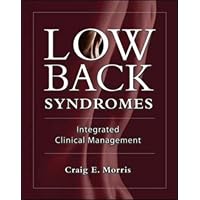
Average Reviews:

(More customer reviews)Low Back Syndromes - Integrated Clinical Management
Ed. Morris, C
(McGraw-Hill Medical Publishers -2006)
My first thought when I saw the first edition of Dr. Craig Morris' Low Back Syndromes - Integrated Clinical Management was, "Will this book be of any use to me?" As an allopathic doctor (i.e., "regular medical doctor"), I did what most of us do - I checked out the quality of the book's information in my specialty, Occupational Medicine. What I found amazed and excited me - the subject matter was relevant and detailed. The writers were the best people in their fields and, most appealing, almost all of the chapters contained useful tools, i.e., well-referenced copies of standard assessment and outcome measurement tools. The visual analogue scale for pain, the Oswestry back disability scale, and the FABQ psychological outcome measure tools were ready to use, to name a few. Equally important, there was clear instruction describing how and when to use them!
The quality of the contributing authors is astounding. These luminaries included Dr. Rick Delamater, the orthopedic spine surgeon from UCLA famous for his pioneering work on artificial discs, Professor Vert Mooney, the orthopedist who revolutionized non-operative management of herniated discs, and Professor Vladimir Janda, the internationally famous neurologist and rehabilitation medicine physician who pioneered neuromotor control and spinal stabilization strategies.
The book is organized around low back syndrome identification and treatment. All the relevant areas of expertise (allopathic medicine, osteopathic medicine, physical therapy, chiropractic, psychology and surgery) are covered in excellent detail and, most important to me, all are well referenced. The book's coverage of pure medical issues includes chapters on pain medicine, surgical management and recovery, occupational medicine, neurology and psychological issues. Each of these fields are covered by experts who give very practical insights that can be applied in medical practice.
As low back disorders are some of the most difficult cases we treat, having top practitioners in their fields describe and explain how their specialty looks at, diagnoses, and manages low back syndromes is an enormous benefit to an allopathic medical practitioner (i.e., "regular" MD) who needs to manage the complex back problems of real patients. In addition to the medical issues, chapters in the book describe physical therapy, chiropractic and psychology management strategies. These give a detailed and broad picture of the tools and practical techniques professionals in these areas use. Of greatest interest to me was the information (well referenced!) on current standards and clinical end points accepted by these fields. Did you know that physical therapists perform manipulation and mobilization and that chiropractors perform exercise and rehabilitation?
Chapters of particular interest to an Occupational Physicians such as myself include:
Occupational Medicine Chapter (Ch. 34): This chapter, written by Dr. Alan Colledge (Director of the Utah Workers' Compensation system and developer of the SPICE model) describes to the occupational physician what the options are for complex low back pain and how you go about implementing them.
Psychological Screening Chapter (Ch. 19): this chapter answers one question that I always struggle with, i.e., when is it appropriate to send a back patient for psychological evaluation, what happens in this process and what do you do with the outcome.
Evidence-based Treatment of Back Pain Chapter (Ch 31): This chapter is written by Professor Nikolai Bogduk (an internationally renowned physician and a leading authority on pain management). This chapter is a gem and describes a step-by-step, practical, evidence-based guide for the regular practitioner to handle back pain.
Post Surgical Management/Rehabilitation Section: This contains chapters on radiology (which technologies are best for which spinal disorders), neurology (which neurodiagnostic tests to run and when), minimally invasive techniques (what ARE those pain management techniques and when do they apply) and each of these sections is of enormous practical utility.
As noted, Dr. Morris' book covers medicine, surgery, physical therapy, chiropractic, osteopathy and psychology. If you are an expert in one of these areas, but not all (this is the typical situation, of course), this essential book provides an invaluable explanation of current standards of practices among all the key fields impacting low back disorders and injuries. It also gives well referenced insight into answers to questions like, "What are your clinical options from other fields?", "What kind of evaluation and treatment can you expect from all these different specialists?", "What are the end points used by other specialists and on what success do they base their therapies?", and "What are standards of practice in each of these other specialty areas?".
Dr. Morris indicated that his purpose in writing the book was (1) to share the science-based rationales for the different approaches to the spine, (2) to reduce the barriers between professionals in different specialties and (3) to promote better management of patients. He achieved these goals and Low Back Syndromes succeeds both as a serious, practical and careful scientific work, and also as a singular book of ambassadorship among the different spine care disciplines.
If you want to provide the optimal, evidence-based management for your spine patients, utilizing the wisdom and accumulated knowledge of ALL the important disciplines, this book is an essential tool.
Constantine Gean, MD, MS, MBA, FACOEM, FACPM
Chief Medical Officer, Unum Group, Inc.
Associate Clinical Professor, Volunteer faculty,
Department of Medicine, Division of Occupational and Environmental Medicine
University of California at Irvine
Click Here to see more reviews about: Low Back Syndromes: Integrated Clinical Management
Click here for more information about Low Back Syndromes: Integrated Clinical Management

No comments:
Post a Comment